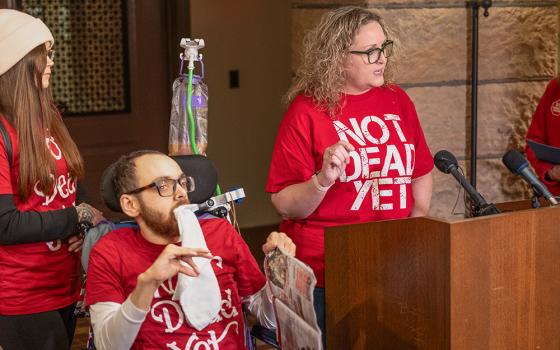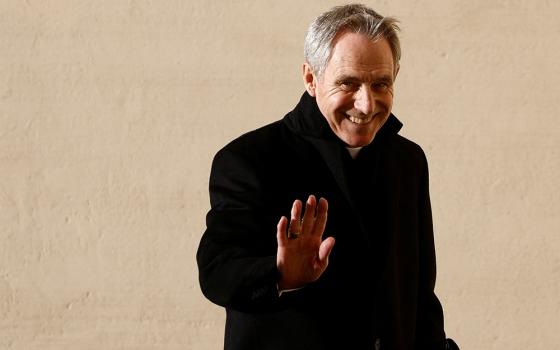In the forty-plus years since the close of the Second Vatican Council (1962-65), two schools of thought have circled one another in Catholicism about how to interpret what the council meant. For lack of a better vocabulary, what we might call the "change" school sees Vatican II as a significant innovation in Catholic life, ushering in a new period of reform in liturgy, doctrine, and pastoral practice. The "continuity" school instead stresses a smooth continuum between Vatican II and previous councils.
In early July, the continuity school notched up two big wins.
On July 7, Pope Benedict XVI released his long-awaited motu proprio liberalizing permission for the pre-Vatican II Mass, insisting that the council never meant to suppress the earlier rite. On July 10, the Congregation for the Doctrine of the Faith put out an interpretation of the famous Vatican II statement that the church of Christ "subsists in" the Catholic church, rather than simply "is" the Catholic church. Ecumenists had long taken this phrasing as a recognition that no existing church, including Catholicism, can claim to be the one true church, but the congregation rejected that reading. Instead, the congregation said, the phrase was intended to show that all the elements instituted by Christ endure in the Catholic church.
In addition to Catholics troubled by the resuscitation of the Tridentine Mass, many Jews were offended by the fact that a prayer for the conversion of Jews was not deleted from the Good Friday liturgy. Meanwhile, many Protestants have called the declaration on the "true" church hurtful, though Metropolitan Kirill of Smolensk and Kaliningrad, who heads the Department for External church Relations of the Russian Orthodox church, welcomed it: "For an honest theological dialogue to happen, one should have a clear view of the position of the other side," he said. Kirill said he prefers its blunt tone to "so-called church diplomacy."
The logical question many reporters and ordinary Catholics alike are asking is, "Why now?" What's prompting the Vatican to re-open such sensitive questions?
My answer is that these moves cannot be seen in isolation. They are part of what I have identified as one of the ten "Mega-Trends" in Catholicism today, which is the reassertion of a strong sense of traditional Catholic identity.
In light of this week's events, it seemed a good time to share a selection from the chapter of my upcoming book, Mega-Trends in Catholicism, devoted to Catholic identity. I hope it provides some context to understand what's happening.
* * *
Anyone who regards the statement, "I'm a card-carrying Catholic" as a mere metaphor clearly has never met Marian Mulhall.
An advertising and communications executive in Dublin, Ireland, Mulhall decided in 2005 to combine her professional skills with her commitment to the church. Her aim is to develop programs to support priests, but first she had to come up with a product that would generate revenue. Thus she began pitching what she calls the "Catholic Identity Card." For $44 individually, or $173 for a "family pack" of five, a Catholic can obtain a credit-card sized piece of plastic bearing the holder's name, a picture of Pope Benedict XVI, a holographic icon showing the hands of a priest breaking the Eucharistic host, and a phrase in bold letters stating: "I am a Catholic. In the event of an accident or emergency, please contact a priest."
Mulhall explains the appeal this way: "It should be carried with you always. In doing so it makes a clear statement that you are a Catholic, that you make no apologies for being a Catholic, and that in fact you are proud to be a Catholic."
Historically speaking, it says a great deal about social change in contemporary Ireland that it would occur to anyone that a card might be necessary to identify the bearer as a member of the Catholic church. Even a generation ago, Ireland was still a largely homogenous Catholic culture, with rates of weekly Mass attendance in excess of 80 percent. The mere fact someone was moving about generally was sufficient to fix their religious affiliation. Marketing a card to remind people they're Catholic would have been akin to selling them a card to remind them that they're Irish, and since the British would never let them forget it, one cannot imagine the sales potential would have been terribly strong.
Mulhall's brainstorm is among the paradoxes of secularization in today's Europe, where there's money to be made selling people tokens of an identity that their peers, or their parents, chucked away for nothing.
Whatever its fate on the open market, the Catholic Identity Card is one of the most literal expressions of the powerful "Catholic identity" movement coursing through the global church, particularly in the affluent North. External symbols of Catholic belonging, the more distinctive the better, are in vogue. Sociologists say that groups assert their identity in this manner when they can no longer take it for granted. The Catholic identity movement is therefore an effect, of which runaway secularization in the global North, especially Europe, is the immediate cause.
Post-Vatican II, any teaching or behavior that made Catholics seem alien was frowned upon, and a good bit of it was cast aside. In 1967, for example, the bishops of England and Wales eliminated the requirement of abstaining from meat on Fridays with this explanation: "Non-Catholics know and accept that we do not eat meat on Fridays, but often they do not understand why we do not, and in consequence regard us as odd." Given the temper of the times, this was understood as an argument against the practice. Today, the winds are blowing the other way. A perception of Catholic singularity has become an argument in favor of doing things, such as wearing religious habits and saying the Mass in Latin.
It's little mystery why practicing Catholics, or for that matter religious believers of any sort, feel compelled to affirm their identity in today's Europe. The ethos of secular European opinion found its epigrammatic expression in 2003, when journalist David Margolick interviewed then-Prime Minister Tony Blair of England for a piece in Vanity Fair magazine, and asked Blair about the impact of his Christian faith on his politics. Blair's spin doctor at the time, Alistair Campbell, cut the conversation short: "I'm sorry," he said, "but we don't do God."
Sociological data lends credence to Campbell's assertion. Today, just 21 percent of Europeans say religion is "very important" to them, according to the most recent European Values Study. According to the same study, while attendance at religious services varies across the continent, overall just 15 percent of Europeans attend church at least once a week, as opposed to 44 percent of Americans. The most extreme example is France, where only five percent say they attend religious services regularly, and a whopping 60 percent said "never or almost never."
The impact of secularization can also be located in steep declines in vocations to the priesthood and religious life, as well as the vanishing public influence of the church across Europe and in other parts of the developed world. Cultural elites in Europe and elsewhere are increasingly hostile to what they perceive the Catholic church to represent.
In 21st century Europe, Catholicism perceives itself as an embattled minority. The same sensation obtains to varying degrees in other parts of the developed world, such as Australia and New Zealand, Canada, and the United States. In response, Catholicism in these zones is doing what embattled minorities always do, practicing what sociologists call the "politics of identity" -- aggressively reinforcing traditional markers of thought, language, dress, and behavior, in order to resist assimilation to what Benedict XVI calls this "dictatorship of relativism."
New translations of the rites and rituals of the Catholic church which are closer to Roman patterns, and dusting off the pre-Vatican II Mass, illustrate the trend, along with a growing emphasis on individual confession and Eucharistic adoration. Marian devotion is also staging a strong comeback, measured in part by the success of pilgrimage sites such as Lourdes, Fatima and Medjugorje. In the priesthood and religious life, one finds a return to habits and Roman collars, especially among younger priests, deacons, brothers, and sisters. Debates in Catholic universities and hospitals about what makes them "Catholic," as well as efforts to tighten up on admissions and curricula in Catholic seminaries, are also part of this picture. Bishops insisting that Catholic politicians cannot defy church teaching and still wear the label "Catholic" likewise expresses the identity impulse.
The idea that defense of Catholic identity constitutes a core force in the church is not mere journalistic extrapolation. In March 2007, Cardinal Tarcisio Bertone, the Vatican's Secretary of State and hence the number two official in the church after the pope himself, addressed the Ethics and Finance Association in the city of Milan. Speaking just ahead of the second anniversary of the election of Benedict XVI to the papacy, Bertone offered this formula to characterize the "main objective" of Benedict's pontificate: "To recover the authentic Christian identity and to explain and confirm the intelligibility of the faith in the context of widespread secularism."
A more classic expression of the Roman Catholic "politics of identity" is difficult to imagine.
To employ an inter-faith metaphor that captures the spirit of what I'm describing, Catholicism today is engaged in the same project that gripped Judaism after the destruction of the Temple and the dispersal of the Jewish people into a worldwide diaspora -- that is, "building a fence around the Law." The idea is that by making the external markers of one's religious identity clear and absolute, those who observe them will also preserve the deep spiritual values those markers are meant to embody, even when there's little support for doing so in the surrounding cultural universe.
In the language of sociologist Rodney Stark, it is an option for a "high tension" form of religion, deliberately set apart from the values of the larger society. Whatever one makes of its merits or prospects for success, the construction of this fence is driving policy in virtually every area of Catholic life, above all in the global North, and will continue to do so throughout the 21st century.
There are, I should note, at least two possible objections to this way of surveying the lay of the land.
Some will complain that what I'm calling "Catholic identity" is really only one form of Catholic identity, and a fairly narrow one at that, perhaps held only by the hierarchy and a small cluster of traditionalists. At the grass roots, they say, Catholic identity is worked out by the laity in a variety of ways, drawing upon church teaching and tradition, but also their life experience and common sense.
In 2005, American sociologist Dean Hoge published an extensive survey about how American Catholics define what it means to be Catholic. At the top of their list was belief in the resurrection of Jesus, the Eucharist and the other sacraments, and helping the poor. Other traditional markers of identity were sidelined -- only 29 percent said a celibate male clergy was important, and just 42 percent said that about the teaching authority of the Vatican. Seventy-six percent said one could be a good Catholic without going to Mass on Sunday, and 75 percent said the same about following church teaching on birth control. Looking at those results, some would conclude that Catholic identity can't be imposed from on high, and that the church ought to listen more to what its people are saying.
As Hoge put it, "Boundaries that make no sense to young adults cannot be maintained over the long haul."
Others will be happy to concede that what I'm calling "Catholic identity" is the real deal, but will complain that I'm making it sound like a purely defensive reaction against the threat of secularism, when historically it's the other way around -- secularism is a modern defection from the vision of human life taught by the Catholic church, one which is progressively running out of gas.
Reaffirmation of traditional aspects of church life and practice is not just nostalgia or fear, these Catholics insist, but the fruit of deep reflection on how Catholicism should engage modernity that goes back at least as far as Pope Leo XIII in the late 19th century. That project may have gone off the rails a bit following the Second Vatican Council, they say, but what happened under Pope John Paul II and now under Benedict XVI is the resumption of a historical process with a compelling logic of its own, not an irrational stampede set off by panic that the French aren't going to church, or that the Italians aren't having babies.
Let me be clear: either, or both, of these arguments may be absolutely correct. My aim is not to settle the normative question of what Catholic identity ought to be, but rather to describe the version of Catholic identity that is currently driving policy.
Neither am I trying to analyze the intellectual history out of which this understanding of Catholic identity emerged. Of course it's not purely random; if all the identity movement were about is ensuring that Catholics are different, we might as well wear kilts and speak Esperanto. Rather, I'm trying to explain why the church is emphasizing traditional expressions of its identity now with a greater intensity than 30 or 40 years ago. To say that the Catholic identity movement is a reaction to secularization is not to assert that it doesn't have deeper intellectual and spiritual roots.
Because of the ideological and political freight it carries, the "Catholic identity" mega-trend uniquely inspires prescriptive debate: "Is this the way we ought to go, or not?" While that's a worthwhile matter to ponder, it's not what this chapter is about, which aims instead to outline what's happening and to anticipate some of its consequences. I do so in the spirit of Nelson Mandela, who once said that debating the desirability of globalization is a bit like debating winter -- whether you like it or not, it's coming. Today's press for Catholic identity is a lot like that.
The e-mail address for John L. Allen Jr. is jallen@ncronline.org




